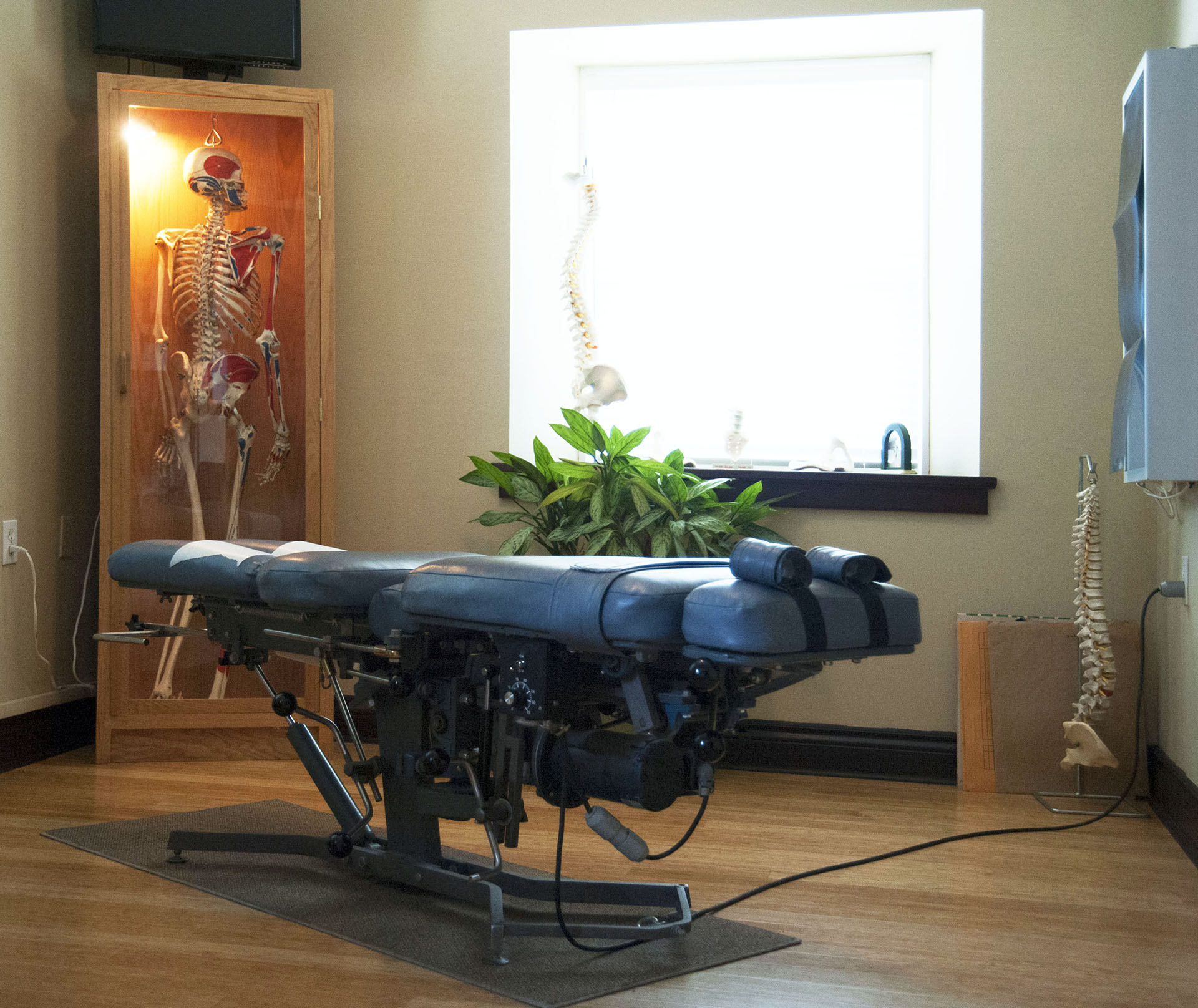Chiropractic Care for Healthy Joints & Biomechanical Restoration
Find out how joint and biomechanical restoration from chiropractic care can help restore function and alleviate discomfort.
Chiropractic Care for Joint and Biomechanical Restoration: A Comprehensive Guide
Key Points
- Chiropractic Care Overview: Chiropractic care focuses on diagnosing and treating musculoskeletal disorders, particularly spinal issues, to improve joint function and overall health through non-invasive techniques like spinal adjustments.
- Joint and Biomechanical Benefits: Research suggests chiropractic adjustments may help restore joint mobility, reduce pain, and improve biomechanical function by addressing spinal misalignments, though results vary by individual.
- Environmental Factors and Joint Pain: Factors like poor posture, repetitive stress, or environmental triggers may contribute to joint pain, which chiropractic care may alleviate by improving alignment and reducing inflammation.
- Dr. Alexander Jimenez’s Role: Dr. Jimenez, a chiropractor in El Paso, TX, is noted for his expertise in personal injury cases, using advanced imaging and diagnostics to assess injuries and support legal documentation.
- Holistic Health Connections: Emerging research, such as studies on the gut-brain axis and mitochondrial function, suggests chiropractic care may indirectly support overall health by reducing stress and improving nervous system function.
- Disclaimer: While chiropractic care shows promise, its effectiveness can vary, and it should be part of a comprehensive treatment plan. Always consult a healthcare professional for personalized advice.
Introduction to Chiropractic Care
Chiropractic care is a healthcare profession centered on the musculoskeletal system, particularly the spine. It operates on the principle that spinal misalignments, or subluxations, can disrupt nerve function, leading to pain, reduced mobility, and other health issues. Chiropractors use hands-on techniques, such as spinal adjustments, to realign the spine and joints, aiming to restore function and promote the body’s natural healing processes. This approach is non-invasive, making it an appealing option for those seeking alternatives to surgery or medication.
For high school students or anyone new to the concept, think of your spine as the body’s main highway for nerve signals. If there’s a traffic jam (misalignment), it can cause problems like pain or stiffness. Chiropractors work to clear those jams, helping your body run smoothly. While some swear by it for everything from back pain to headaches, others debate its effectiveness for certain conditions, so it’s worth exploring with an open mind.
How Chiropractic Care Helps Joints and Biomechanics
Chiropractic care is particularly valued for its potential to restore joint function and improve biomechanics—the way your body moves. Misaligned joints or a spine out of whack can lead to pain, stiffness, or even compensatory injuries elsewhere in the body. For example, a misaligned lower back might make your knees work harder, leading to discomfort over time. Chiropractic adjustments aim to correct these misalignments, potentially reducing pain and improving movement.
Research suggests that spinal manipulation can enhance joint mobility and reduce inflammation, which is crucial for conditions like osteoarthritis. While not a cure-all, these adjustments may help by improving blood flow and reducing stress on affected joints. Imagine your joints as rusty hinges—chiropractic care might act like oil, helping them move more freely.
Dr. Alexander Jimenez and Personal Injury Cases
In El Paso, TX, Dr. Alexander Jimenez stands out as a chiropractor with expertise in personal injury cases, such as those from car accidents or workplace injuries. His practice, accessible via ChiroMed, emphasizes advanced imaging (like MRI or CT scans) and diagnostic evaluations to assess injuries thoroughly. Dr. Jimenez’s ability to connect medical findings with legal documentation makes him a valuable liaison for patients navigating personal injury claims. His work ensures that injuries are accurately documented, which is critical for both treatment and legal outcomes.
Picture this: after a fender-bender, your neck feels like it’s auditioning for a role as a creaky door in a haunted house. Dr. Jimenez uses tools like X-rays or MRIs to figure out what’s wrong, then crafts a treatment plan to get you moving again—while also helping your lawyer make sense of it all.
Environmental Factors and Joint Pain
Joint pain isn’t just about aging or injury; environmental factors like poor posture, repetitive motions, or even stress from a hectic lifestyle can play a role. Sitting hunched over a desk all day or carrying a heavy backpack can strain your spine and joints, leading to discomfort. Chiropractic care may help by addressing these biomechanical issues, potentially reducing pain caused by environmental stressors.
For instance, repetitive tasks like typing or lifting can cause micro-injuries, which chiropractic adjustments might mitigate by restoring proper alignment. It’s like hitting the reset button on your body’s mechanics, though results depend on the individual and the severity of the issue.
Broader Health Connections
Chiropractic care doesn’t exist in a vacuum—it’s part of a broader health picture. Research, like studies on the gut-brain axis, suggests that stress and nervous system dysfunction can affect overall health, including joint function. Chiropractic adjustments may reduce stress on the nervous system, potentially influencing systems like digestion or even mood. While direct links are still being studied, the idea is that a well-aligned spine supports better communication between your brain and body.
Think of it like tuning a guitar: when the strings (your nervous system) are in tune, the music (your health) sounds better. This holistic view is why chiropractors often emphasize lifestyle factors like diet and exercise alongside adjustments.
Comprehensive Report on Chiropractic Care for Joint and Biomechanical Restoration
Introduction to Chiropractic Care
Chiropractic care is a healthcare discipline rooted in the belief that the spine’s alignment directly impacts the nervous system and overall health. Founded in the late 19th century, it focuses on diagnosing and treating mechanical disorders of the musculoskeletal system, particularly the spine. Chiropractors use manual techniques, such as spinal adjustments, to correct subluxations—misalignments that may interfere with nerve function, leading to pain, reduced mobility, or other health issues. The goal is to restore proper alignment, enhance joint function, and promote the body’s natural healing abilities without relying on drugs or surgery.
For a high school audience, imagine your spine as the body’s control center, like the wiring in a house. If a wire gets pinched, the lights might flicker or go out. Chiropractic adjustments aim to unpinch those wires, helping your body function smoothly. While many patients report relief from back pain, neck pain, or headaches, the effectiveness of chiropractic care for certain conditions remains debated in the medical community, highlighting the need for personalized treatment plans.
The Science Behind Joint and Biomechanical Restoration
Chiropractic care is particularly effective for addressing joint and biomechanical issues, which involve how your body moves and functions. Subluxations can disrupt nerve signals, leading to pain, stiffness, or compensatory injuries in other areas. For example, a misaligned lower back might cause your hips or knees to overcompensate, resulting in discomfort or injury over time. Chiropractic adjustments aim to restore proper alignment, improving joint mobility and reducing stress on surrounding tissues.
Research supports the potential benefits of spinal manipulation for joint restoration. For instance, studies suggest that chiropractic care can improve sensorimotor integration, which is how the brain processes sensory information to control movement (Haavik & Murphy, 2007). This is particularly relevant for conditions like osteoarthritis, where mitochondrial dysfunction and oxidative stress contribute to joint degeneration (Blanco et al., 2011). By improving local blood flow and reducing inflammation, chiropractic adjustments may support joint health, though outcomes vary by patient.
To add a light-hearted touch, think of your joints as the hinges on a squeaky gate. Chiropractic care is like applying a bit of WD-40—easing the creaks and helping things swing smoothly again. However, it’s not a one-size-fits-all fix, and combining it with other therapies like physical therapy or exercise often yields the best results.
Table 1: Common Conditions Addressed by Chiropractic Care
| Condition | How Chiropractic Helps |
|---|---|
| Lower Back Pain | Realigns spine to reduce nerve irritation and improve mobility. |
| Neck Pain | Adjusts cervical spine to alleviate tension and restore range of motion. |
| Osteoarthritis | May reduce inflammation and improve joint function through better alignment. |
| Headaches | Addresses spinal misalignments that may contribute to tension or migraine headaches. |
| Sciatica | Relieves pressure on the sciatic nerve through targeted adjustments. |
References
Blanco, F. J., Rego, I., & Ruiz-Romero, C. (2011). The role of mitochondria in osteoarthritis. Nature Reviews Rheumatology, 7(2), 89–98. https://pubmed.ncbi.nlm.nih.gov/21119608/
Haavik, H., & Murphy, B. (2007). Cervical spine manipulation alters sensorimotor integration: A somatosensory evoked potential study. Clinical Neurophysiology, 118(2), 391–402. https://pubmed.ncbi.nlm.nih.gov/17141595/
Environmental Factors and Joint Pain
Joint pain often stems from more than just aging or injury—environmental factors play a significant role. Poor posture from slouching over a phone, repetitive motions like typing, or carrying heavy loads can strain joints and muscles, leading to discomfort. Stress, another environmental factor, can exacerbate pain by increasing muscle tension and inflammation. Chiropractic care addresses these issues by correcting biomechanical imbalances and reducing stress on the nervous system.
For example, repetitive strain injuries from workplace tasks can cause micro-traumas in joints, leading to pain and reduced function. Chiropractic adjustments may help by restoring proper alignment, improving joint mobility, and reducing inflammation. Additionally, environmental stressors like cold weather or poor ergonomics can worsen conditions like arthritis, and chiropractic care may offer relief by enhancing circulation and reducing joint stress.
Humorously, imagine your spine as a grumpy old bridge that groans under the weight of bad posture or heavy backpacks. Chiropractic care is like sending in a repair crew to shore it up, making sure it doesn’t collapse under the daily grind. However, it’s worth noting that while chiropractic care can help, it’s most effective when paired with lifestyle changes like better ergonomics or stress management.
Dr. Alexander Jimenez: A Leader in Personal Injury Care
In El Paso, TX, Dr. Alexander Jimenez, DC, APRN, FNP-BC, is a distinguished chiropractor known for his expertise in personal injury cases, such as those resulting from car accidents or workplace incidents. His practice, detailed at ChiroMed and his LinkedIn profile, emphasizes advanced diagnostic tools like MRI, CT scans, and dual-scope procedures to assess injuries comprehensively. Dr. Jimenez’s ability to translate medical findings into legal documentation makes him a critical liaison for patients navigating personal injury claims.
For instance, in a car accident, whiplash can cause subtle but debilitating spinal misalignments. Dr. Jimenez uses advanced imaging to pinpoint these issues, creating detailed reports that support both treatment and legal proceedings. His holistic approach ensures patients receive tailored care while their injuries are accurately documented for insurance or court purposes. This dual role is particularly valuable in El Paso, where personal injury cases are common due to the city’s busy roads and active workforce.
To lighten the mood, think of Dr. Jimenez as a detective with a stethoscope, piecing together clues from X-rays and MRIs to solve the mystery of your pain—while also helping your lawyer build a rock-solid case. His work underscores the importance of specialized chiropractic care in personal injury recovery.
The Role of Chiropractic Care in Improving Your Health- Video
Integrating Research: The Broader Health Context
Chiropractic care’s benefits extend beyond the spine, potentially influencing overall health through connections like the gut-brain axis, mitochondrial function, and neural plasticity. Below, we explore how research from the provided links supports a holistic view of chiropractic care.
Gut-Brain Axis and Neurological Health
The gut-brain axis describes the bidirectional communication between the gut microbiome and the brain, influencing neurological health (Cryan et al., 2019). Stress or spinal misalignments can disrupt this axis, potentially worsening conditions like anxiety or even motor dysfunction. Chiropractic adjustments may indirectly support gut health by reducing stress and improving vagal nerve function, which regulates digestion. While direct evidence linking chiropractic care to gut health is limited, the nervous system’s role in this axis suggests potential benefits.
Reference
Cryan, J. F., O’Riordan, K. J., Cowan, C. S. M., Sandhu, K. V., Bastiaanssen, T. F. S., Boehme, M., … & Dinan, T. G. (2019). The gut microbiome in neurological disorders. The Lancet Neurology, 19(2), 179–194. https://pubmed.ncbi.nlm.nih.gov/31753762/
Mitochondrial Function and Osteoarthritis
Mitochondrial dysfunction contributes to osteoarthritis by increasing oxidative stress and cartilage degradation (Blanco et al., 2011). Chiropractic care may help by improving joint alignment and circulation, potentially reducing inflammation and supporting cellular health. While not a direct treatment for mitochondrial issues, adjustments may complement other therapies by alleviating mechanical stress on joints.
Reference
Blanco, F. J., Rego, I., & Ruiz-Romero, C. (2011). The role of mitochondria in osteoarthritis. Nature Reviews Rheumatology, 7(2), 89–98. https://pubmed.ncbi.nlm.nih.gov/21119608/
Brain Plasticity and Spinal Cord Injuries
Brain plasticity, or the brain’s ability to reorganize neural pathways, is critical for recovery from spinal cord injuries (SCI) (Nudo, 2013). Chiropractic care, combined with rehabilitation, may support functional recovery by improving sensory input and motor control through spinal adjustments. This is particularly relevant for personal injury cases, where Dr. Jimenez’s diagnostic expertise can guide targeted interventions.
Reference
Nudo, R. J. (2013). Brain plasticity in patients with spinal cord injuries: A systematic review. Journal of Neurotrauma, 30(19), 1681–1694. https://pubmed.ncbi.nlm.nih.gov/23879585/
Nutrition and Brain Function
Diet plays a significant role in brain health, with nutrients like omega-3 fatty acids supporting cognitive function (Gómez-Pinilla, 2008). Chiropractors often recommend dietary changes alongside adjustments to optimize health outcomes. For example, a balanced diet may reduce inflammation, complementing chiropractic care’s effects on joint health.
Reference
Gómez-Pinilla, F. (2008). Brain foods: The effects of nutrients on brain function. Nature Reviews Neuroscience, 9(7), 568–578. https://pubmed.ncbi.nlm.nih.gov/18568016/
Aging and Metabolic States
Aging involves changes like telomere shortening and mitochondrial dysfunction, which can affect joint and neurological health (López-Otín et al., 2013). Chiropractic care may support healthy aging by reducing mechanical stress and improving nervous system function, though more research is needed to confirm these effects.
Reference
López-Otín, C., Blasco, M. A., Partridge, L., Serrano, M., & Kroemer, G. (2013). Hallmarks of brain aging: Adaptive and pathological modification by metabolic states. Cell Metabolism, 18(5), 617–631. https://pubmed.ncbi.nlm.nih.gov/23702481/
Low-Level Light Therapy
Low-level light therapy (LLLT) has been explored for its potential to stimulate healing in tissues, including the brain and eyes (Hamblin, 2016). While not a standard chiropractic technique, some practitioners incorporate LLLT to enhance recovery, potentially complementing spinal adjustments.
Reference
Hamblin, M. R. (2016). Low-level light therapy of the eye and brain. Eye and Brain, 8, 77–89. https://pubmed.ncbi.nlm.nih.gov/28539775/
Neural Substrates and Posture Control
The brain’s neural substrates, including sensory and motor regions, regulate posture and balance (Takakusaki, 2017). Chiropractic adjustments may influence these substrates by improving sensory input from spinal joints, potentially enhancing stability and reducing fall risk.
Reference
Takakusaki, K. (2017). Neural substrates involved in the control of posture. Advanced Robotics, 31(1–2), 2–23. https://www.tandfonline.com/doi/abs/10.1080/01691864.2016.1249376
Other Research Insights
Additional studies highlight the complexity of health interactions:
- Calcium Signaling and Excitotoxicity: Dysregulated calcium signaling can contribute to neuronal damage, potentially worsened by spinal misalignments (Orrenius et al., 2003). Chiropractic care may indirectly support neural health by optimizing nervous system function.
- Gut-Liver-Brain Axis: This axis connects gut, liver, and brain functions, influencing overall health (Bajaj et al., 2019). Chiropractic care’s stress-reducing effects may support this axis indirectly.
- Mitochondrial ROS Generation: Reactive oxygen species (ROS) from mitochondria contribute to aging and disease (Zorov et al., 2014). Chiropractic care may reduce oxidative stress by improving circulation.
- Sex Hormones and Brain Function: Hormonal changes affect brain health, potentially influencing pain perception (Craft, 2007). Chiropractic care may help manage pain related to hormonal imbalances.
- Ketogenic Diet and Immune Function: The ketogenic diet may modulate immune responses, potentially complementing chiropractic care’s anti-inflammatory effects (Pinto et al., 2018).
References
Orrenius, S., Zhivotovsky, B., & Nicotera, P. (2003). Endoplasmic reticulum Ca2+ release through ryanodine and IP3 receptors contributes to neuronal excitotoxicity. Nature Reviews Neuroscience, 4(7), 552–562. https://pubmed.ncbi.nlm.nih.gov/12838337/
Bajaj, J. S., Kakiyama, G., Savidge, T., & Takei, H. (2019). Gut-liver-brain axis in diseases: The implications for therapeutic interventions. Hepatology, 70(4), 1457–1469. https://pubmed.ncbi.nlm.nih.gov/30924953/
Zorov, D. B., Juhaszova, M., & Sollott, S. J. (2014). Mitochondrial electron transport chain, ROS generation and uncoupling. International Journal of Biochemistry & Cell Biology, 56, 89–97. https://pubmed.ncbi.nlm.nih.gov/25282678/
Craft, R. M. (2007). Understanding the broad influence of sex hormones and sex differences in the brain. Journal of Neuroscience Research, 85(12), 2589–2601. https://pubmed.ncbi.nlm.nih.gov/17348036/
Pinto, A., Bonucci, A., Maggi, E., Corsi, M., & Bussolati, O. (2018). Ketogenic diet suppressed T-regulatory cells and promoted cardiac fibrosis via reducing mitochondria-associated membranes and inhibiting mitochondrial function. Nutrients, 10(8), 1032. https://pubmed.ncbi.nlm.nih.gov/30096909/
Dr. Jimenez’s Expertise in Personal Injury Cases
Dr. Alexander Jimenez’s work in El Paso highlights the critical role of chiropractic care in personal injury cases. His use of advanced imaging and dual-scope procedures allows for precise diagnosis of injuries, such as whiplash or spinal trauma, which are common in accidents. By providing detailed medical reports, Dr. Jimenez bridges the gap between healthcare and legal systems, ensuring patients receive both effective treatment and proper documentation for their claims.
His practice integrates chiropractic adjustments with diagnostic tools to address biomechanical issues, reduce pain, and support recovery. This comprehensive approach is particularly valuable in personal injury cases, where accurate assessment and documentation can significantly impact outcomes. For example, a patient with post-accident back pain might benefit from adjustments to restore spinal alignment, while Dr. Jimenez’s diagnostics ensure the injury’s extent is clear for legal purposes.
To inject some humor, imagine Dr. Jimenez as a superhero with a chiropractic cape, swooping in to fix your spine and save your court case with a single X-ray. His work exemplifies how specialized chiropractic care can make a difference in complex injury scenarios.
Table 2: Dr. Jimenez’s Approach to Personal Injury Cases
| Aspect | Description |
|---|---|
| Advanced Imaging | Uses MRI, CT scans, and X-rays to assess injury extent and guide treatment. |
| Diagnostic Evaluations | Employs dual-scope procedures for precise diagnosis of musculoskeletal issues. |
| Legal Documentation | Provides detailed reports linking injuries to medical findings for legal claims. |
| Treatment Plans | Combines chiropractic adjustments with rehabilitation for holistic recovery. |
References
ChiroMed. (n.d.). Chiropractic services in El Paso, TX. Retrieved from https://chiromed.com/
Jimenez, A. (n.d.). LinkedIn profile. Retrieved from https://www.linkedin.com/in/dralexjimenez/
Conclusion
Chiropractic care offers a promising approach to addressing joint and biomechanical issues by focusing on spinal alignment and nervous system function. Research suggests it may improve joint mobility, reduce pain, and support overall health by influencing systems like the gut-brain axis or reducing inflammation in conditions like osteoarthritis. In El Paso, Dr. Alexander Jimenez exemplifies the field’s potential, particularly in personal injury cases, where his expertise in diagnostics and legal documentation provides comprehensive care.
While chiropractic care shows significant benefits, its effectiveness varies by individual, and it should be part of a broader treatment plan. Always consult a licensed healthcare professional to determine the best approach for your needs. This post is for informational purposes only and is not a substitute for medical advice.
Disclaimer: The information provided is based on current research and clinical insights but is not exhaustive. Chiropractic care’s benefits and limitations are still being studied, and individual results may vary. Seek professional guidance before pursuing any treatment.
















